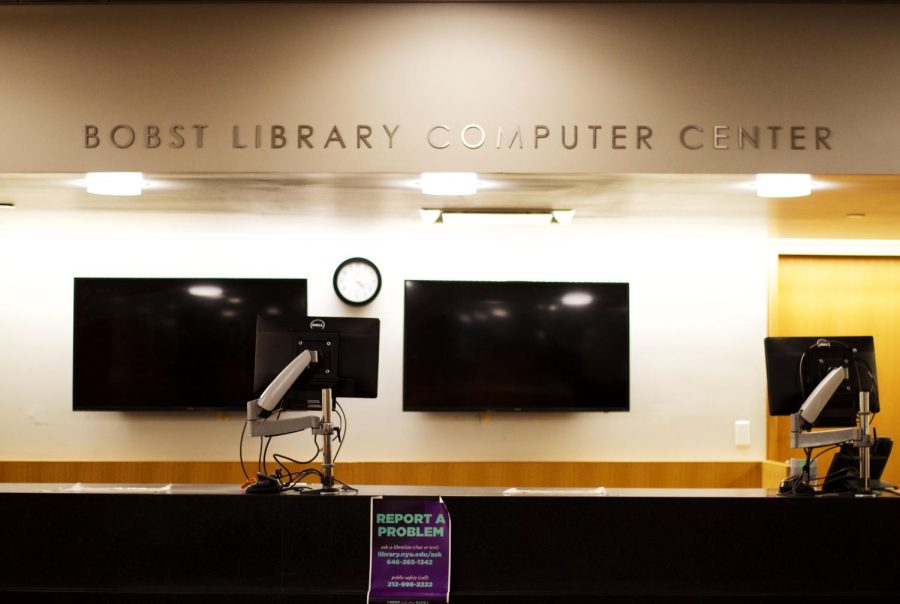Opinion: Bobst should stop playing CNN on that one TV all the time
Since LL1-16 has been converted into a study space, it should be fully treated as one. Watch Anderson Cooper on your own time.
Most students go to Bobst Library to study and focus, not to get bombarded by the 24-hour news cycle. So turn off the TVs on Lower Level 1. (Staff Photo by Camila Ceballos)
February 25, 2022
If you spend serious time at Bobst Library, you know about LL1-16. It’s the glass-encased room located just off the staircases down from the lobby. Before NYU adjusted its COVID-19 restrictions again, LL1-16 used to be the only place in the library where you could eat. It’s still filled with the individual desks where students were allowed to eat for 15 minutes at a time, though the round room of vending machines — or, as my friends and I like to call it, the Snack Coliseum — is now blocked off by recycling bins. The “Quick Stop” signs have been replaced with “No Eating” ones. The room has been converted into a makeshift study space. But one big thing that hasn’t changed about LL1-16 is the flatscreen TV built into the wall of the Snack Coliseum: it has served, and continues to serve, a constant stream of CNN.
There’s nothing wrong with staying up to date with Anderson Cooper, and CNN does provide comprehensive coverage of most mainstream media events. But the channel plays nearly 24 hours a day, into the early hours of the morning when students are only at Bobst because they have to be. The TV is disruptively out of place in the new environment of LL1-16 and it should be turned off.
Now that LL1-16 is not an eating area, students use it as an additional study room. Students should have a distraction-free environment to be able to be productive, especially given the intensive coursework that NYU offers. But those studying in LL1-16 compared to other Bobst study areas are at an automatic disadvantage because of the TV. Anderson Cooper is lovely, but when I’m struggling through a problem set due in an hour, he isn’t the person I want to see. Moving away from the room is also not always an option. The lower levels are the only parts of Bobst open all night except for finals week. For late-night studiers, the lower levels are the only place to go. Not to mention, space in Bobst can be notoriously hard to find — with an estimated seating capacity of 2,600 students to house a student body of 50,000, it’s easy to see why. Any seat is a strike of luck.
The topic coverage of CNN isn’t ideal for a study environment, either. Journalists’ jobs are to provide breaking news coverage of all kinds of events, and more often than not those events are terrible. President Putin’s recent invasion of Ukraine is an unfortunate example of this. Russia’s, America’s and Ukraine’s actions could affect us all imminently, and they’re something we should be well aware of. That being said, listening to live updates about military movements is hardly going to help me finish my Texts and Ideas reading, much less retain anything from it. Students are already stressed. We won’t be able to focus or maintain our mental health if that stress is magnified at the library — the one place you’re supposed to be guaranteed a quiet study.
Many students bridge the gap between silent study and former eating space by using LL1-16 as a hangout spot with friends. CNN isn’t conducive to a relaxing social hangout, either. The colorful moving graphics of news channels are designed to grab attention, taking it away from the group you’re with. The sobering topics take away a chance at a distraction from everything, and we’re left with no actual respite.
As a journalism student myself, I understand the value of news. It’s critical to being educated. But I make judgments about when I’m able to pay attention to the news, and when other variables in my life demand my immediate attention. The LL1-16 TV takes away that choice from students every day, for hours on end. So, turn it off — what’s the harm? I’m pretty sure no one wants to pay attention anyways.
Contact Jules Roscoe at [email protected].




























































































































































